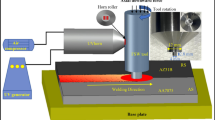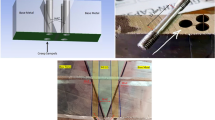Abstract
In order to improve the mechanical properties of welding, the welding quality of butt-welded by the application of CO2 arc vibratory welding was evaluated by tensile strength, fatigue life, microhardness, deformation, and residual stress. In addition, butt-welded microstructures of 16Mn were observed to illustrate the mechanical property changes by CO2 arc vibratory welding. The results showed that the mechanical properties were improved, and the distortion and residual stress were reduced. The mechanism was studied from microstructure observation, and the main improvement reasons were refinement of grain and microstructure change in welding zones and overheated zones. Furthermore, the mechanism of grain refinement in CVW is analyzed from the increase in nucleation rate and decrease in growth rate.
Similar content being viewed by others
References
Sakthivel P, Sivakumar P (2014) Effect of vibration in tig and arc welding using AISI316 stainless steel. Int J Engg Res & Sci & Tech 3(4):116–130
Ahiale GK, Oh YJ (2014) Microstructure and fatigue performance of butt-welded joints in advanced high-strength steels. Mater Sci Eng A 597:342–348
Adak M, Soares CG (2014) Effects of different restraints on the weld-induced residual deformations and stresses in a steel plate. Int J Adv Manuf Technol 71(1–4):699–710
Daavari M, Vanini SAS (2015) The effect of ultrasonic peening on service life of the butt-welded high-temperature steel pipes. J Mater Eng Perform 24(9):3658–3665
Deplus K, Simar A, Van Haver W (2011) Residual stresses in aluminium alloy friction stir welds. Int J Adv Manuf Technol 56(5–8):493–504
Zaletelj H, Fajdiga G, Nagode M (2013) Low cycle fatigue of welded joints with aging influence. Mater Sci Eng A 564:478–484
Xu J, Chen L, Ni C (2007) Effect of vibratory weld conditioning on the residual stresses and distortion in multipass girth-butt welded pipes. Int J Pres Ves Pip 84(5):298–303
Qinghua L, Ligong C, Chunzhen N (2008) Effect of vibratory weld conditioning on welded valve properties. Mech Mater 40(7):565–574
Kainth M, Gupta D (2015) A review: effect of vibrations on mechanical properties of welded joints. IJME 2(1):7–12
Jose MJ, Kumar SS, Sharma A (2015) Vibration assisted welding processes and their influence on quality of welds. Sci Technol Weld Joi 21(4):234–258
Aoki S, Kurita K, Koshimizu S (2012) Analytical method for reduction of residual stress using low frequency and ultrasonic vibrations. Journal of Solid Mechanics and Materials Engineering 6(6):742–749
Kou S, Le Y (1985) Improving weld quality by low frequency arc oscillation. Weld J 64(3):51–55
Chen L, Ni C (2008) Effect of vibratory weld conditioning on welded valve properties. Mech Mater 40(7):565–574
Rao D, Wang D, Chen L (2007) The effectiveness evaluation of 314 L stainless steel vibratory stress relief by dynamic stress. Int J Fatigue 29(1):192–196
Lu Q, Chen L, Ni C (2007) Improving welded valve quality by vibratory weld conditioning. Mater Sci Eng A 457(1):246–253
Yang YP (2009) Understanding of vibration stress relief with computation modeling. J Mater Eng Perform 18(7):856–862
Ashtiani HRR, Zarandooz R (2016) Microstructural and mechanical properties of resistance spot weld of Inconel 625 supper alloy. Int J Adv Manuf Technol 84(1–4):607–619
Bahadur A, Kumar BR, Kumar AS (2004) Development and comparison of residual stress measurement on welds by various methods. Mater Sci Tech-Lond 20(2):261–269
Rossini NS, Dassisti M, Benyounis KY (2012) Methods of measuring residual stresses in components. Mater Design 35:572–588
ASTM E837-92 (1992) Standard Test Method for Determining Residual Stresses by the Hole-Drilling Strain-Gage Method, Annual Book of ASTM Standards, 2nd edn. American Society for Testing and Materials, Philadelphia, p 747–753 Section 3
Wang Q, Liu Z, Wang B, Song Q, Wan Y (2016) Evolutions of grain size and micro-hardness during chip formation and machined surface generation for Ti-6Al-4 V in high-speed machining. Int J Adv Manuf Technol 82(9–12):1725–1736
Hussein AR, Jail NA, Talib ARA (2011) Improvement of mechanical welding properties by using induced harmonic vibration. J Appl Sci 11:348–353
Torres MAS, Voorwald HJC (2002) An evaluation of shot peening, residual stress and stress relaxation on the fatigue life of AISI 4340 steel. Int J Fatigue 24(8):877–886
Chen BQ, Soares CG (2016) Numerical and experimental investigation on the weld-induced deformation and residual stress in stiffened plates with brackets. Int J Adv Manuf Technol:1–11
Savage WF, Lundin CD, Aronson AH (1965) Weld metal solidifications mechanics. Weld J 44(4):175–181
Author information
Authors and Affiliations
Corresponding author
Rights and permissions
About this article
Cite this article
Liang, X., Wan, Y., Zhang, C. et al. Comprehensive evaluation of welding quality for butt-welded by means of CO2 arc vibratory welding. Int J Adv Manuf Technol 90, 1911–1920 (2017). https://doi.org/10.1007/s00170-016-9504-5
Received:
Accepted:
Published:
Issue Date:
DOI: https://doi.org/10.1007/s00170-016-9504-5




